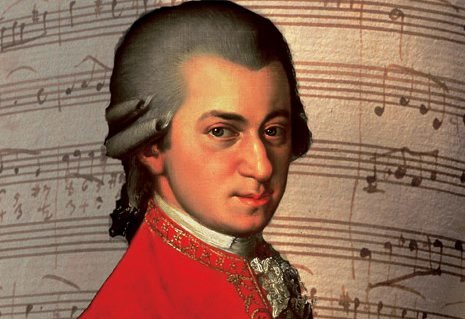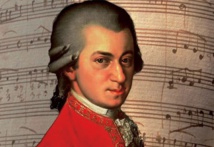"Then I started reading the notes, and realised it is the famous A Major sonata... My heart rate shot up," he told AFP as he proudly showed off his precious discovery.
The four yellowed pages that Mikusi found in a dark corner of the library earlier this year were nothing short of a sensation.
How they came to be there is a bit of a mystery.
The Piano Sonata No. 11 in A Major (K.331) happens to be very widely known, its soothing and sublimely relaxing opening melody instantly recognisable.
"This is one of the best known Mozart pieces," said the music historian Adam Bosze.
"Along with 'Eine Kleine Nachtmusik' or the first movement of the G minor symphony, the tune of the Turkish March (the final movement of the sonata) is Mozart's best known melody.
"Every kid knows how to whistle it," he said.
- 'Premiere' -
The sonata was written around 1783. Like most of Wolfgang Amadeus Mozart's works, the score was then copied down.
But the original manuscript was thought to be lost, with only one surviving page preserved in Salzburg, where the master was born.
"It is very rare that a Mozart manuscript pops up. Moreover the A Major Sonata had no known manuscript, so it is a really big discovery," said Bosze.
The manuscript was revealed to the public on Friday evening at the National Szechenyi Library with Hungarian pianist and conductor Zoltan Kocsis playing the sonata.
And to the trained ear, a few differences are noticeable from the version known to the world, with a few tiny modifications in notes and rhythm.
"It won't change our view on Mozart, and it doesn't change the character of the music, but we get a lot better sense of what Mozart wanted to achieve," said Mikusi.
- Not even looking -
The bespectacled and animated Mikusi, 42, originally an expert not in Mozart but in fellow composer Joseph Haydn, joined the National Szechenyi Library in 2009.
His mission for the past five years, he says, has been to "look into every dark corner", painstakingly going through the many hundred folders of uncategorised manuscripts gathering dust.
"I wasn't looking for Mozart, but it wasn't accidental either that I found it," he says.
To verify what he had found, he cross-checked it with the surviving page in Salzburg and sent photos to Mozart experts around the world. They confirmed it to be genuine.
Mozart (1756-1791) is not believed to have ever set foot in Hungary.
It is therefore a mystery how the manuscript wound up in the national library, established in 1802 by Count Ferenc Szechenyi, a rich aristocrat.
"The Szechenyis had good contacts in Vienna and in the music world too, but it basically could have ended up here anytime in the past 200 years," Mikusi said.
The fact that the manuscript's last page was somewhere else suggests it may have been ripped apart as a souvenir to be given to wealthy patrons, he added.
Later the manuscript will briefly be reunited with the last page in Salzburg's Mozarteum Foundation. Then it will be moved from the unmarked folder to its rightful place at Szechenyi Library's vault, to be put on display from time to time.
----------------------------------------------------------------------------------------------------------------------
The four yellowed pages that Mikusi found in a dark corner of the library earlier this year were nothing short of a sensation.
How they came to be there is a bit of a mystery.
The Piano Sonata No. 11 in A Major (K.331) happens to be very widely known, its soothing and sublimely relaxing opening melody instantly recognisable.
"This is one of the best known Mozart pieces," said the music historian Adam Bosze.
"Along with 'Eine Kleine Nachtmusik' or the first movement of the G minor symphony, the tune of the Turkish March (the final movement of the sonata) is Mozart's best known melody.
"Every kid knows how to whistle it," he said.
- 'Premiere' -
The sonata was written around 1783. Like most of Wolfgang Amadeus Mozart's works, the score was then copied down.
But the original manuscript was thought to be lost, with only one surviving page preserved in Salzburg, where the master was born.
"It is very rare that a Mozart manuscript pops up. Moreover the A Major Sonata had no known manuscript, so it is a really big discovery," said Bosze.
The manuscript was revealed to the public on Friday evening at the National Szechenyi Library with Hungarian pianist and conductor Zoltan Kocsis playing the sonata.
And to the trained ear, a few differences are noticeable from the version known to the world, with a few tiny modifications in notes and rhythm.
"It won't change our view on Mozart, and it doesn't change the character of the music, but we get a lot better sense of what Mozart wanted to achieve," said Mikusi.
- Not even looking -
The bespectacled and animated Mikusi, 42, originally an expert not in Mozart but in fellow composer Joseph Haydn, joined the National Szechenyi Library in 2009.
His mission for the past five years, he says, has been to "look into every dark corner", painstakingly going through the many hundred folders of uncategorised manuscripts gathering dust.
"I wasn't looking for Mozart, but it wasn't accidental either that I found it," he says.
To verify what he had found, he cross-checked it with the surviving page in Salzburg and sent photos to Mozart experts around the world. They confirmed it to be genuine.
Mozart (1756-1791) is not believed to have ever set foot in Hungary.
It is therefore a mystery how the manuscript wound up in the national library, established in 1802 by Count Ferenc Szechenyi, a rich aristocrat.
"The Szechenyis had good contacts in Vienna and in the music world too, but it basically could have ended up here anytime in the past 200 years," Mikusi said.
The fact that the manuscript's last page was somewhere else suggests it may have been ripped apart as a souvenir to be given to wealthy patrons, he added.
Later the manuscript will briefly be reunited with the last page in Salzburg's Mozarteum Foundation. Then it will be moved from the unmarked folder to its rightful place at Szechenyi Library's vault, to be put on display from time to time.
----------------------------------------------------------------------------------------------------------------------









 Home
Home Politics
Politics











